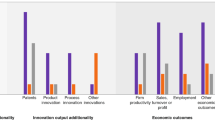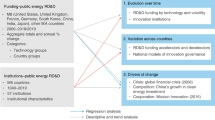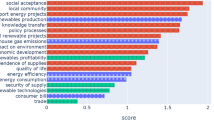Abstract
Accelerating the development and deployment of energy technologies is a pressing challenge. Doing so will require policy reform that improves the efficacy of public research organizations and strengthens the links between public and private innovators. With their US$14 billion annual budget and unique mandates, the US National Laboratories have the potential to critically advance energy innovation, yet reviews of their performance find several areas of weak organizational design. Here, we discuss the challenges the National Laboratories face in engaging the private sector, increasing their contributions to transformative research, and developing culture and management practices to better support innovation. We also offer recommendations for how policymakers can address these challenges.
This is a preview of subscription content, access via your institution
Access options
Subscribe to this journal
Receive 12 digital issues and online access to articles
$119.00 per year
only $9.92 per issue
Buy this article
- Purchase on Springer Link
- Instant access to full article PDF
Prices may be subject to local taxes which are calculated during checkout



Similar content being viewed by others
References
Nelson, R. R. U. S. technological leadership: Where did it come from and where did it go? Res. Policy 19, 117–132 (1993).
Nelson, R. R. (ed.) National Innovation Systems (Oxford Univ. Press, 1993).
Bush, V. Science: The Endless Frontier (US Gov. Printing Office, 1945).
Mazzucato, M. The Entrepreneurial State: Debunking Public vs. Private Sector Myths (Anthem Books, 2013).
Anadon, L. D. Missions-oriented R&D institutions in energy: A comparative analysis of China, the United Kingdom, and the United States. Res. Policy 41, 1742–1756 (2012).
Spence, M. Cost reduction, competition, and industry performance. Econometrica 52, 101–122 (1984).
David, P., Hall, B. & Toole, A. Is public R&D a complement or substitute for private R&D? A review of the econometric evidence. Res. Policy 29, 497–529 (2000).
A Companion to Science and Engineering Indicators 2008 (NSB, 2008).
Science and Engineering Indicators 2014 Ch. 4 (NSB, 2014).
Glauthier, T. J. et al. Securing America's future: Realizing the potential of the DOE National Laboratories. Final Report of the Commission to Review the Effectiveness of the National Energy Laboratories Vol. 1 (DOE, 2015).
Eight National Labs Offer Streamlined Partnership Agreements to Help Industry Bring New Technologies to Market (DOE, 2012).
Report of the Secretary of Energy Task Force on DOE National Laboratories (SEAB, 2015).
Mowery, D. C., Nelson, R. R. & Martin, B. R. Technology policy and global warming: Why new policy models are needed (or why putting new wine in old bottles won't work). Res. Policy 39, 1011–1023 (2010).
Federal Technology Transfer Summary Reports 1987–2009 (NIST, 2011).
Federal Funds for R&D (NSF, 2013).
Managing for High-Quality Science and Engineering at the NNSA National Security Laboratories (NRC, National Academies Press, 2012).
Protein Structures Through use of ‘Superbends’ at the Advance Light Source (DOE, 2014).
Differential Microwave Radiometer and the Cosmic Microwave Background (DOE, 2014).
Federal Research: Information on DOE's Laboratory-Directed Research and Development Program (US Government Accountability Office, 2016).
Laboratory Directed Research and Development (LDRD) at the DOE National Laboratories (DOE, 2014).
Logar, N., Narayanamurti, V. & Anadon, L. D. Maximizing the return on investment. In Transforming U. S. Energy Innovation (eds Anadon, L. D., Bunn, M. & Narayanamurti, V. ) (Cambridge Univ. Press, 2014).
Management Challenges at the Department of Energy Report No. DOE/IG-0858 (DOE, 2011).
Madia, W. Stanford's input to the Commission to Review the Effectiveness of the National Energy Laboratories. Presentation to the Commission to Review the Effectiveness of the National Laboratories (2014); http://go.nature.com/2c6DDae
Positioning DOE's Labs for the Future: A Review of DOE's Management and Oversight of the National Laboratories (NAPA, 2013).
Lester, R. K. A roadmap for U. S. nuclear energy innovation. Issues Sci. Tech. Vol. 32 (2016).
Andes, S., Muro, M. & Stepp, M. Going local: Connecting the National Labs to their regions to maximize innovation and growth. Advanced Industries Series Vol. 38 (Brookings Institution, 2014).
Koonin, S. E. & Gopstein, A. Accelerating the pace of energy change. Issues Sci. Tech. Vol. 27 (2011).
Federal Energy Research and Development for the Challenges of the Twenty-First Century (PCAST, 1997).
Westwick, P. J. The National Labs: Science in an American System 1947–1974 (Harvard Univ. Press, 2003).
Stirling, A. Pluralising progress: From integrative transitions to transformative diversity. Environ. Innov. Soc. Transit. 1, 82–88 (2011).
Concurrent Resolution on the Budget — Fiscal Year 2017. Report of the Committee on the budget House of Representatives. 114th Congress, 2nd Session, Report 114–470 (US House of Representatives, 2016).
Stevenson-Wydler Technology Innovation Act of 1980 (Congress of the United States of America, 1980); http://go.nature.com/2bHZMxt
Schacht, W. H. Technology transfer: Use of federally funded research and development. US Congr. Res. Serv. 7–5700 (FAS, 2012).
Mowery, D. & Rosenberg, N. Technology and the Pursuit of Economic Growth (Cambridge Univ. Press, 1989).
Arthur, W. B. The Nature of Technology: What It Is and How It Evolves (Penguin, 2009).
Rosenberg, N. Inside the Black Box: Technology and Economics (Cambridge Univ. Press, 1983).
Chan, G. Essays on Energy Technology Innovation Policy PhD thesis Ch. 2, Harvard Univ. (2015).
Stokes, D. E. Pasteur's Quadrant – Basic Science and Technological Innovation (Brookings Institution Press, 1997).
Narayanamurti, V. & Odumosu, T. Cycles of Invention and Discovery: Rethinking the Endless Frontier (Harvard Univ. Press, 2016).
Currall, S. C., Frauenheim, E., Perry, S. J. & Hunter, E. M. Organized Innovation: A Blueprint for Renewing America's Prosperity (Oxford Univ. Press, 2014).
Argonne National Lab launches its first tech incubator. Argonne National Laboratory (6 June 2016); http://go.nature.com/2bZ7YZv
Godin, B. The linear model of innovation the historical construction of an analytical framework. Sci. Tech. Hum. Val. 31, 639–667 (2006).
Narayanamurti, V., Odumosu, T. & Vinsel, L. RIP: The basic/applied research dichotomy. Issues Sci. Tech. Vol. 29 (2013).
Alternative Futures for the Department of Energy National Laboratories (SEAB, 1995).
Narayanamurti, V., Anadon, L. D. & Sagar, A. D. The Road to a New Energy System: Transforming energy innovation. Issues Sci. Tech. Vol. 26 (2009).
Anadon, L. D., Chan, G. & Lee, A. Expanding and better targeting US investment in energy innovation: an analytical approach. In Transforming U. S. Energy Innovation (eds Anadon, L. D., Bunn, M. & Narayanamurti, V. ) (Cambridge Univ. Press, 2014).
Cyranoski, D. Chinese science gets mass transformation – Teamwork at center of Chinese Academy of Sciences reform. Nature 513, 468–469 (2014).
Main Science and Technology Indicators Full Dataset (OECD, 2015); http://go.nature.com/2bPhRnx
Laboratory Directed R&D Annual Reports 2007–2014 (DOE, 2007–2014).
Gallagher, K. S. & Anadon, L. D. DOE Budget Authority for Energy Research, Development and Demonstration Database. (Energy Technology Innovation Policy research group, Belfer Center for Science and International Affairs, Harvard Kennedy School, 2016); http://go.nature.com/2bHXpdY
Program Direction FY 2017, Budget At-A-Glance (DOE, 2016); http://go.nature.com/2cvAfYw
Neal, H. A., Smith, T. L. & McCormick, J. B. Beyond Sputnik (Univ. Michigan Press, 2011).
What is an FFRDC? (IDA, 2016); http://go.nature.com/2cj5ZMh
LaBarge, J. Laboratory Directed Research and Development. DOE Order 413.2B Admin Chg 1 (DOE, 2011).
Fleming, L. & Sorenson, O. Science as a map in technological search. Strat. Management J. 25, 909–928 (2004).
Roach, M. & Cohen, W. M. Lens or Prism? Patent citations as a measure of knowledge flows from public research. Management Sci. 59, 504–525 (2013).
Schrage, M. Just how valuable is Google's ‘20% time’? Harvard Business Review (20 August 2013); http://go.nature.com/2bPlOIZ
Acknowledgements
We acknowledge funding from the Harvard Kennedy School Science, Technology and Public Policy (STPP) programme and the Harvard Dissertation Completion Fellowship. We are most grateful to J. Deutch, S. Koonin, A. Majumdar and S. Maxted for their comments on an early version of this work.
Author information
Authors and Affiliations
Corresponding author
Ethics declarations
Competing interests
The authors declare no competing financial interests.
Supplementary information
Supplementary Data 1
Data and calculations underlying Figs 1–3 (XLSX 74 kb)
Rights and permissions
About this article
Cite this article
Anadon, L., Chan, G., Bin-Nun, A. et al. The pressing energy innovation challenge of the US National Laboratories. Nat Energy 1, 16117 (2016). https://doi.org/10.1038/nenergy.2016.117
Received:
Accepted:
Published:
DOI: https://doi.org/10.1038/nenergy.2016.117
This article is cited by
-
Patenting and business outcomes for cleantech startups funded by the Advanced Research Projects Agency-Energy
Nature Energy (2020)
-
Modernizing federal technology transfer metrics
The Journal of Technology Transfer (2020)
-
Six principles for energy innovation
Nature (2017)
-
Rescue US energy innovation
Nature Energy (2017)
-
Energy storage deployment and innovation for the clean energy transition
Nature Energy (2017)



